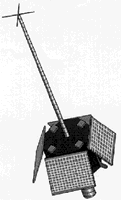REX
Radiation Experiment
 The REX satellites are designed to study scintillation effects of the Earth's
atmosphere on RF transmissions. Rex 2 was also the first spacecraft to successfully employ GPS navigation for full closed loop attitude control. The basic design features of both spacecraft are similar, though there are some obvious differences, i.e. no GPS equipment on the first REX. Specifications presented here are for Rex 2.
The REX satellites are designed to study scintillation effects of the Earth's
atmosphere on RF transmissions. Rex 2 was also the first spacecraft to successfully employ GPS navigation for full closed loop attitude control. The basic design features of both spacecraft are similar, though there are some obvious differences, i.e. no GPS equipment on the first REX. Specifications presented here are for Rex 2.
Spacecraft
Three axis stabilized, nadir pointing to within 5 degrees. Passive attitude control provided by 21 foot gravity gradient boom with two 20 inch long nickel/iron magnetic hysteresis rods mounted at the tip for damping purposes (4 lbs. total). Active control acieved through pitch bias momentum system, including one wheel and three torque coils. Attitude determination is provided by GPS equipment, coarse sun sensors, and a magnetometer.
Payload
The primary communications experiment built by the US Air Force Rome Laboratories advances research on electron density irregularities that cause diruptive scintillation effects on radio signals transmitted through the Earth's ionosphere. Rex II GPS receivers, supplied by Trimble Navigation, are able to resolve spacecraft position to 100m, velocity to 0.2 m/sec, and attitude to within 0.3 deg.
| Country of Origin | United States |
| Customer/User | US Air Force Space Test Program (STP) |
| Manufacturer(s) | CTA Space Systems |
| Size | 8 sided, 30 inch diameter, 22 inches tall |
| Orbit | REX I: 770 x 870 km, 89.6 deg. inclination
REX II: 450 nm cicular, 90 deg. inclination |
| Design Life | 1 year, goal of three years |
Launch Facts
| Name | Int'l Desig. | Date | Site | Vehicle | Orbit | Mass(kg) |
| Notes | ||||||
| REX | 1991-045A | 6/29/91 | WSMC | Scout G1 | LEO | 85 |
| Radiation Experiment; tested communications components in high radiation environment | ||||||
| REX 2 | 1996-014A | 3/9/96 | WSMC | Pegasus | LEO | 110 |
| Radiation Experiment; communications tests | ||||||
Information in The Mission and Spacecraft Library is provided without warranty or guarantee. USE AT YOUR OWN RISK.